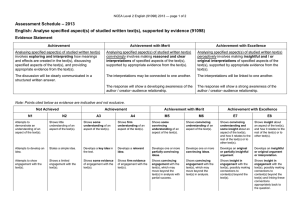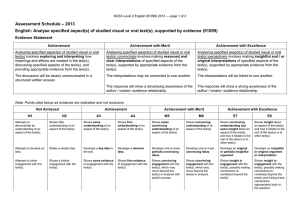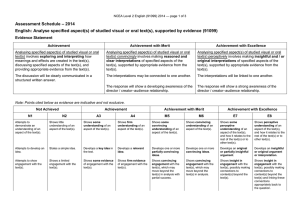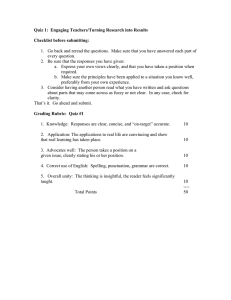– 2014 Assessment Schedule
advertisement
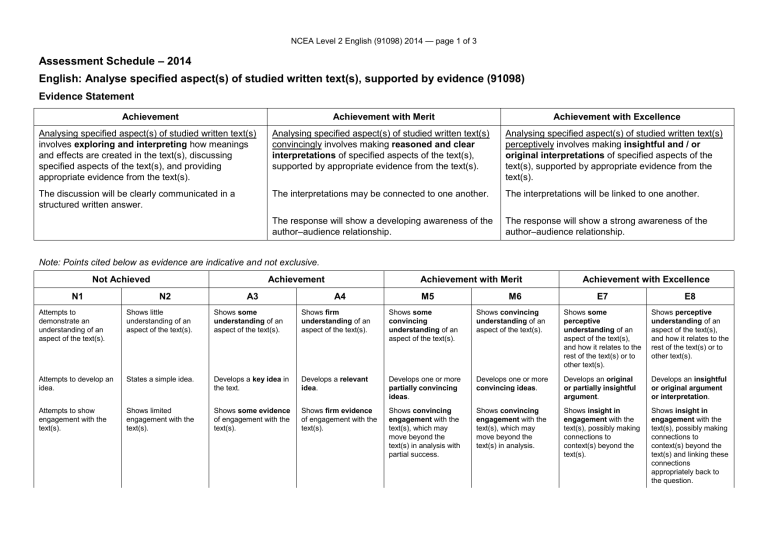
NCEA Level 2 English (91098) 2014 — page 1 of 3 Assessment Schedule – 2014 English: Analyse specified aspect(s) of studied written text(s), supported by evidence (91098) Evidence Statement Achievement Achievement with Merit Achievement with Excellence Analysing specified aspect(s) of studied written text(s) involves exploring and interpreting how meanings and effects are created in the text(s), discussing specified aspects of the text(s), and providing appropriate evidence from the text(s). Analysing specified aspect(s) of studied written text(s) convincingly involves making reasoned and clear interpretations of specified aspects of the text(s), supported by appropriate evidence from the text(s). Analysing specified aspect(s) of studied written text(s) perceptively involves making insightful and / or original interpretations of specified aspects of the text(s), supported by appropriate evidence from the text(s). The discussion will be clearly communicated in a structured written answer. The interpretations may be connected to one another. The interpretations will be linked to one another. The response will show a developing awareness of the author–audience relationship. The response will show a strong awareness of the author–audience relationship. Note: Points cited below as evidence are indicative and not exclusive. Not Achieved N1 Achievement N2 A3 Achievement with Merit A4 M5 M6 Achievement with Excellence E7 E8 Attempts to demonstrate an understanding of an aspect of the text(s). Shows little understanding of an aspect of the text(s). Shows some understanding of an aspect of the text(s). Shows firm understanding of an aspect of the text(s). Shows some convincing understanding of an aspect of the text(s). Shows convincing understanding of an aspect of the text(s). Shows some perceptive understanding of an aspect of the text(s), and how it relates to the rest of the text(s) or to other text(s). Shows perceptive understanding of an aspect of the text(s), and how it relates to the rest of the text(s) or to other text(s). Attempts to develop an idea. States a simple idea. Develops a key idea in the text. Develops a relevant idea. Develops one or more partially convincing ideas. Develops one or more convincing ideas. Develops an original or partially insightful argument. Develops an insightful or original argument or interpretation. Attempts to show engagement with the text(s). Shows limited engagement with the text(s). Shows some evidence of engagement with the text(s). Shows firm evidence of engagement with the text(s). Shows convincing engagement with the text(s), which may move beyond the text(s) in analysis with partial success. Shows convincing engagement with the text(s), which may move beyond the text(s) in analysis. Shows insight in engagement with the text(s), possibly making connections to context(s) beyond the text(s). Shows insight in engagement with the text(s), possibly making connections to context(s) beyond the text(s) and linking these connections appropriately back to the question. NCEA Level 2 English (91098) 2014 — page 2 of 3 N1 N2 A3 A4 M5 M6 E7 E8 Attempts to show awareness of the text as crafted. Shows little awareness of the text as crafted. Shows limited awareness of the text(s) having been deliberately crafted. Shows some awareness of the text(s) having been deliberately crafted. Shows awareness of the text(s) having been deliberately crafted. Shows convincing awareness of the text(s) having been deliberately crafted. Shows awareness of the nature of the text as a constructed form, possibly by making judgements. Shows insightful awareness of the nature of the text as a constructed form, including by making judgements. Attempts to show understanding of the author’s purpose. Shows a limited awareness (possibly by implication) of the author’s purpose. Acknowledges (possibly by implication) the author’s purpose. Shows some understanding (possibly by implication) of the author’s purpose in crafting or shaping the text(s). Shows some understanding of the author’s purpose in crafting or shaping the text(s) through the use of particular techniques. Conveys a convincing sense of the author’s purpose in crafting or shaping the text(s) through the use of particular techniques. Shows some insight in discussion of the author’s purpose in crafting or shaping the text(s) through the use of particular techniques. Demonstrates appreciation in discussion of the author’s purpose in crafting or shaping the text(s) through the use of particular techniques. Attempts to use analysis-related terminology. Uses some analysisrelated terminology inaccurately. Uses analysis-related terminology simply, with some accuracy. Uses analysis-related terminology accurately. Uses analysis-related terminology confidently. Uses analysis-related terminology to convincingly discuss features of the text(s). Uses analysis-related terminology to insightfully discuss features of the text(s) in support of a wider argument. Uses analysis-related terminology to insightfully discuss features of the text(s) in support of a wider argument. Writes simplistically. Focuses on plot summary. Writes in a focused manner, with most points addressing the question. Writes in a focused manner, addressing the question. Writes a well-structured answer, which pursues valid idea(s). Writes a well-structured answer, which develops valid idea(s). Writes a cohesive, deliberately planned response. Writes a cohesive, integrated response. Includes little direct evidence from the text(s) that is relevant to the idea. Includes some evidence from the text(s) that is relevant to the idea. Provides some appropriate quotations and evidence from the text(s). Provides clearly relevant quotations and evidence from the text(s). Weaves a range of appropriate evidence throughout the response to support the main ideas. Weaves a range of convincing evidence throughout the response to support the main ideas. Weaves a range of convincing and possibly insightful evidence throughout the response to support the key argument(s). Weaves a range of insightful evidence throughout the response to support and expand on the key argument(s). N0,/ = No response; no relevant evidence. “Specified aspects” are selected (as per Explanatory Note 4 of the standard) from: purposes and audiences ideas (eg character, theme, setting) language features (eg figurative language, syntax, style, symbolism, vocabulary, sound devices) structures (eg part text, whole text, narrative sequence, beginnings and endings). Cut Scores Not Achieved Achievement Achievement with Merit Achievement with Excellence NCEA Level 2 English (91098) 2014 — page 3 of 3 Score range 0–2 3–4 5–6 7–8
